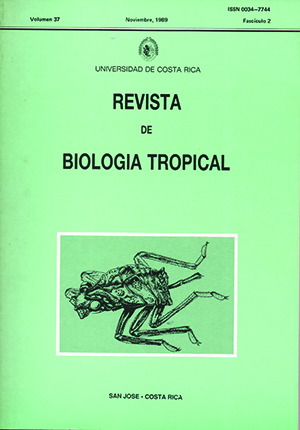Abstract
Se estudiaron las comunidades de insectos de plantas acuáticas de dos represas en Nigeria, Eleiyele y Obadam, la primera con mayor diversidad faunística. En Obadam hay 59 insectos por m2 (16 especies) y en Eleiyele 51 por m2 (14 especies). Los cinco grupos más comunes, en orden decreciente de abundancia, fueron Hemiptera, Odonata, Diptera, Ephemeroptera y Coleoptera. La "lechuga de agua" Pistia stratiotes tenía más insectos, talvez porque provee ventajas en cuanto al área total de refugio y anclaje.References
Cummins, K.W. 1973. Trophic relations of aquatic insect. Ann. Rev. Ent. 18: 183-206.
Fischer, A.G. 1961. Latitudinal variaUons in organic diversity. Amer. Sci. 49(1):50.
Imevbore. A.M.A. 1968. Hydrology and plankton of Elciyele reservoir, Ibadan, Nigeria. Hydrobiologia 31: 37-57.
Krecker, F. H. 1939. A comparative study of the animal population of certain submerged aquatic plants. Ecology 20: 553-561.
Misra, R. 1968. Ecology workbook. Oxford and I.B.II. Publ. Comp. New Delhi. 44 p.
Pennak, R.W. 1953, Freshwater ¡nvertebrates of the United States. Ronald Press, N.Y. 796 p.
Percival, E. & II. Whitehead. 1929. A quantitative study of some type of streambeds. J. Eco. 17:282-304.
Priec, P.W. 1975. lnsect Ecology. John Wiley and Sons, New York. 514 p.
Rosine, W.W. 1955. The distribution of invertebrates on submerged aquatic plant surfaces in Muskee Lake Colorado. Ecology 36: 308-314.
Comments

This work is licensed under a Creative Commons Attribution 4.0 International License.
Copyright (c) 1989 Revista de Biología Tropical


